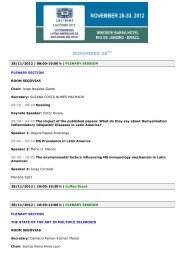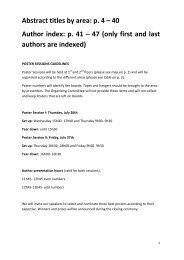Keynote Conference - Interevent
Keynote Conference - Interevent
Keynote Conference - Interevent
Create successful ePaper yourself
Turn your PDF publications into a flip-book with our unique Google optimized e-Paper software.
L#17<br />
Synapse failure induced by Alzheimer's toxic Aβ oligomers<br />
Sérgio Teixeira Ferreira<br />
Biomedical Sciences Institute, Federal University of Rio de<br />
Janeiro (UFRJ), Rio de Janeiro, Brazil<br />
More than one hundred years after its original description, the<br />
mechanisms leading to memory loss and progressive cognitive<br />
impairment in Alzheimer’s disease (AD) remain controversial.<br />
Considerable evidence accumulated during the past decade<br />
implicates soluble oligomers of the amyloid-β peptide (Aβ),<br />
which accumulate in the brains of AD patients, as the proximal<br />
toxins that attack neurons and cause synapse failure<br />
culminating with memory impairment. This presentation will<br />
focus on mechanisms by which Aβ oligomers (AβOs) attack<br />
synapses and negatively impact the function of neuronal<br />
receptors important for synaptic plasticity. We recently<br />
showed that AβOs cause aberrant activation of NMDA<br />
receptors, which triggers dysregulation of intracellular Ca2+<br />
levels, neuronal oxidative stress and receptor internalization.<br />
Similarly, AβOs induce removal of AMPA receptors from<br />
synapses. Along with changes in pre-synaptic neurotransmitter<br />
vesicle release, combined removal of NMDA and AMPA<br />
receptors from synapses may be part of the mechanism by<br />
which AβOs inhibit synaptic plasticity. We also demonstrated<br />
that NMDA receptors play a key role in the binding of Aβ<br />
oligomers to a neuronal receptor complex that putatively<br />
comprises additional protein components, among which the<br />
cellular prion protein. Finally, our recent work has shown that<br />
A Os inhibit neuronal insulin signaling, essential for neuronal<br />
survival, synaptic plasticity and memory formation. Elucidation<br />
of molecular/cellular mechanisms underlying the deleterious<br />
impact of AβOs on synapses may illuminate the development<br />
of novel therapeutic approaches to combat memory loss in AD.<br />
Key words: synaptotoxicity, amyloid- , memory loss<br />
L#18<br />
Collective cancer invasion, tissue guidance, and plasticity of<br />
therapy response<br />
Peter Friedl 1,2<br />
1 Radboud University Nijmegen Medical Centre, Nijmegen, The<br />
Netherlands and<br />
2 The University of Texas, MD Anderson Cancer Center,<br />
Houston, TX, USA<br />
The tumor microenvironment contributes to cancer invasion,<br />
growth and survival with impact on tumor response to therapy.<br />
We here employ intravital infrared multiphoton imaging for the<br />
multi-parameter visualization of cancer invasion, guidance by<br />
the tumor stroma, and therapy response. The data show<br />
predominantly collective cancer cell into the host stroma at<br />
speeds of up to 200 µm per day. Invasion resulted from nondestructive<br />
contact-guidance type migration exploiting<br />
preformed tracks of multi-interface topography, including 1D,<br />
2D and 3D dimensionalities, but was independent of β1 and β3<br />
integrin-mediated mechanotransduction. Collective invasion<br />
was coupled to altered survival capability, withstanding highdose<br />
radiotherapy and forming a resistance niche for<br />
subsequent relapse of the disease. Albeit invasion was integrinindependent,<br />
invasion-associated radioresistance was sensitive<br />
to the β1/β3 integrin targeting by RNAi or antiantibody<br />
treatment, resulting in anoikis induction and regression<br />
of both, tumor lesion and invasion strands. In conclusion,<br />
collective invasion is an important invasion mode in solid tumors<br />
that receive integrin signals from the tissue microenvironment<br />
for acquiring an altered phenotype and improved survival.<br />
51





